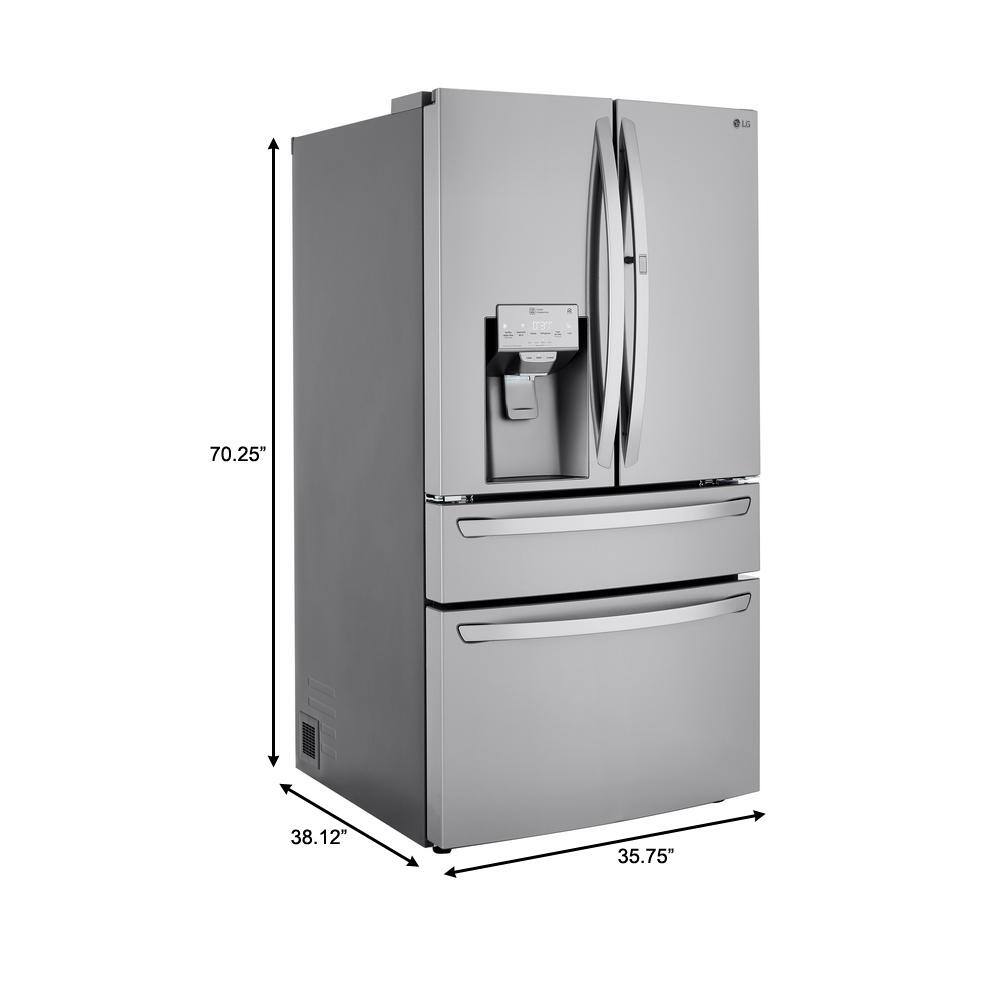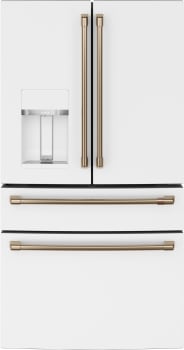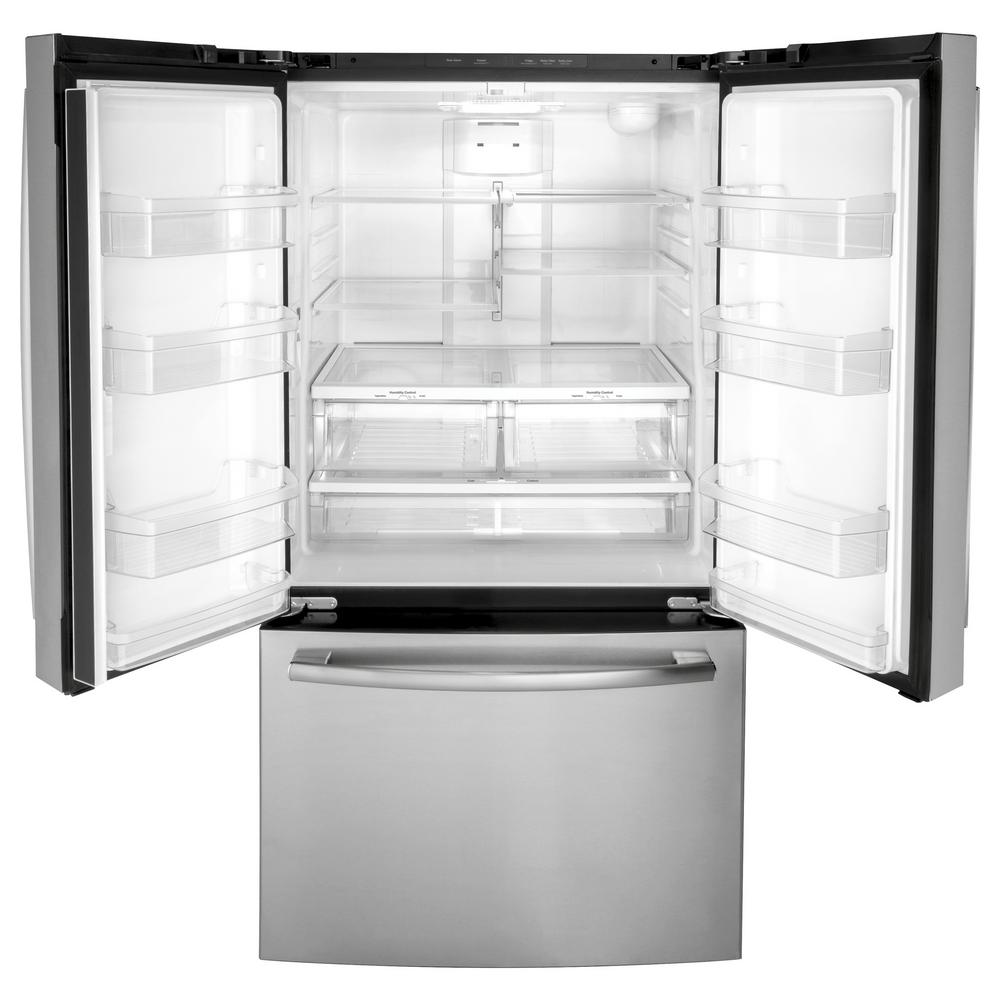LG Electronics 26.1 cu. ft. Side by Side Refrigerator with ColdSaver and Door-in-Door in Stainless Steel
Door-in-Door feature gives quick access and added organization. Slim SpacePlus ice door system frees up valuable shelf space. Smart Cooling system helps keep your food fresher, longer.
With a generous 26 cu. ft. capacity and featuring our Door-in-Door design, this side-by-side refrigerator maximizes food storage space to accommodate all of your family’s food. From post-workout protein shakes to after-school snacks, LG’s Door-in-Door design keeps all your favorites at your fingertips while reducing cold air loss to help keep foods, fresher longer and conserve on precious energy —all with the push of a button. It’s designed with convenient slide-out and folding shelving, tilting and adjustable door bins, and multiple crisper drawers— to help facilitate organization, so you can find just what you need in a snap. Plus, it comes with sophisticated LG styling and features like an intuitive LED display, contoured doors, and Smart Cooling System helps keep your food fresher.
- Nothing beats the convenience of having more food when you need it, and with a generous 26 cu. ft. of space, you’ll have room and room to grow
- For those fly-by visits to the refrigerator, the Door-in-Door feature allows you to get in and get out providing easy access to beverages and snacks. Only LG Door-in-Door models include bonus door bins for added organization and storage
- Door-in-Door with ColdSaver Panel acts like a barrier keeping cold air in where it matters most – in the inside – giving you peace of mind that food will stay fresh longer. It reduces cold air loss to help keep food fresher longer
- Ice makers are great, but not if it means you can’t fit all of your food in the fridge. The Slim SpacePlus Ice System provides the most shelf space and allows even more space for door bins
- From pitchers to pint glasses, finally an ice and water dispenser that can accommodate just about any container. The water and ice dispenser in this LG french door refrigerator is one of the tallest around, measuring in at an ultra-accommodating 12.6 in.
- Smart Cooling system is designed to maintain superior conditions within the refrigerator. The Linear Compressor reacts quickly to temperature fluctuations and helps keep your food fresher, longer. Meanwhile, strategically-placed vents in every section help to surround your food with cool air no matter where you put it
- LED panels located on the rear of the refrigerator provide an exceptionally bright interior and saves energy over traditional lighting
- Humidity-controlled crispers help maintain humidity levels to help extend the life of your fruits and vegetables
- Multi-Air Flow System is designed to maintain superior humidity and temperature levels to help keep your food fresher, longer. Digital sensors constantly monitor conditions within the refrigerator and strategically-placed vents in every section to help surround your food with cool air no matter where you put it
- SmartDiagnosis helps the service center diagnose problems over the phone, helping you troubleshoot quickly
- Contoured doors, hidden hinges, and a host of great interior features give your refrigerator a look that’s as sophisticated as it is functional. And it’s beauty isn’t just the outside. With every feature thoughtfully designed, this appliance helps you create the sophisticated, distinctive kitchen you want—and deserve
- 2-door side-by-side refrigerator has 1 fresh food door and 1 freezer door. With the addition of the Door-in-Door design on this refrigerator, access to beverages and snacks is made easier
- 16.9 cu. ft. fresh food capacity provides spacious interior; 9.2 cu. ft. of freezer space allows for additional storage
Additional information
| Depth (Excluding Handles) | 34 |
|---|---|
| Depth (Including Handles) | 36.31 |
| Depth (Less Door) | 29.06 |
| Depth With Door Open 90 Degrees (In) | 51.13 |
| Height to Top of Door Hinge (in.) | 70.25 |
| Height to Top of Refrigerator (in.) | 69.38 |
| Product Depth x Height x Width (in.) | 36.71 x 70.25 x 35.77 |
| Refrigerator Width (In.) | 35.88 |
| Certifications and Listings | CSA Listed,NSF Listed |
| Manufacturer Warranty | Limited Warranty: 1 Year Parts & Labor, 5 Years Sealed System and Compressor (Parts & Labor), 6-10 Years Linear Compressor (Parts Only) |
1 (one, unit, unity) is a number representing a single or the only entity. 1 is also a numerical digit and represents a single unit of counting or measurement. For example, a line segment of unit length is a line segment of length 1. In conventions of sign where zero is considered neither positive nor negative, 1 is the first and smallest positive integer. It is also sometimes considered the first of the infinite sequence of natural numbers, followed by 2, although by other definitions 1 is the second natural number, following 0.
The fundamental mathematical property of 1 is to be a multiplicative identity, meaning that any number multiplied by 1 equals the same number. Most if not all properties of 1 can be deduced from this. In advanced mathematics, a multiplicative identity is often denoted 1, even if it is not a number. 1 is by convention not considered a prime number; this was not universally accepted until the mid-20th century. Additionally, 1 is the smallest possible difference between two distinct natural numbers.
The unique mathematical properties of the number have led to its unique uses in other fields, ranging from science to sports. It commonly denotes the first, leading, or top thing in a group.
26 may refer to:
- 26 (number), the natural number following 25 and preceding 27
- one of the years 26 BC, AD 26, 1926, 2026
A door is a hinged or otherwise movable barrier that allows ingress (entry) into and egress (exit) from an enclosure. The created opening in the wall is a doorway or portal. A door's essential and primary purpose is to provide security by controlling access to the doorway (portal). Conventionally, it is a panel that fits into the doorway of a building, room, or vehicle. Doors are generally made of a material suited to the door's task. They are commonly attached by hinges, but can move by other means, such as slides or counterbalancing.
The door may be able to move in various ways (at angles away from the doorway/portal, by sliding on a plane parallel to the frame, by folding in angles on a parallel plane, or by spinning along an axis at the center of the frame) to allow or prevent ingress or egress. In most cases, a door's interior matches its exterior side. But in other cases (e.g., a vehicle door) the two sides are radically different.
Many doors incorporate locking mechanisms to ensure that only some people can open them (such as with a key). Doors may have devices such as knockers or doorbells by which people outside announce their presence. (In some countries, such as Brazil, it is customary to clap from the sidewalk to announce one's presence.) Apart from providing access into and out of a space, doors may have the secondary functions of ensuring privacy by preventing unwanted attention from outsiders, of separating areas with different functions, of allowing light to pass into and out of a space, of controlling ventilation or air drafts so that interiors may be more effectively heated or cooled, of dampening noise, and of blocking the spread of fire.
Doors can have aesthetic, symbolic, ritualistic purposes. Receiving the key to a door can signify a change in status from outsider to insider. Doors and doorways frequently appear in literature and the arts with metaphorical or allegorical import as a portent of change.
Electronics is a scientific and engineering discipline that studies and applies the principles of physics to design, create, and operate devices that manipulate electrons and other electrically charged particles. Electronics is a subfield of electrical engineering which uses active devices such as transistors, diodes, and integrated circuits to control and amplify the flow of electric current and to convert it from one form to another, such as from alternating current (AC) to direct current (DC) or from analog signals to digital signals.
Electronic devices have hugely influenced the development of many aspects of modern society, such as telecommunications, entertainment, education, health care, industry, and security. The main driving force behind the advancement of electronics is the semiconductor industry, which in response to global demand continually produces ever-more sophisticated electronic devices and circuits. The semiconductor industry is one of the largest and most profitable sectors in the global economy, with annual revenues exceeding $481 billion in 2018. The electronics industry also encompasses other sectors that rely on electronic devices and systems, such as e-commerce, which generated over $29 trillion in online sales in 2017.
LG Corporation (or LG Group), formerly known as Lucky-Goldstar, is a South Korean multinational conglomerate founded by Koo In-hwoi and managed by successive generations of his family. It is the fourth-largest chaebol (family-run conglomerate) in South Korea. Its headquarters are in the LG Twin Towers building in Yeouido-dong, Yeongdeungpo District, Seoul. LG makes electronics, chemicals, household appliances, and telecommunications products and operates subsidiaries such as LG Electronics, Zenith, LG Display, LG Uplus, LG Innotek, LG Chem, and LG Energy Solution in over 80 countries.
A refrigerator, colloquially fridge, is a commercial and home appliance consisting of a thermally insulated compartment and a heat pump (mechanical, electronic or chemical) that transfers heat from its inside to its external environment so that its inside is cooled to a temperature below the room temperature. Refrigeration is an essential food storage technique around the world. The low temperature lowers the reproduction rate of bacteria, so the refrigerator reduces the rate of spoilage. A refrigerator maintains a temperature a few degrees above the freezing point of water. The optimal temperature range for perishable food storage is 3 to 5 °C (37 to 41 °F). A similar device that maintains a temperature below the freezing point of water is called a freezer. The refrigerator replaced the icebox, which had been a common household appliance for almost a century and a half. The United States Food and Drug Administration recommends that the refrigerator be kept at or below 4 °C (40 °F) and that the freezer be regulated at −18 °C (0 °F).
The first cooling systems for food involved ice. Artificial refrigeration began in the mid-1750s, and developed in the early 1800s. In 1834, the first working vapor-compression refrigeration, using the same technology seen in air conditioners, system was built. The first commercial ice-making machine was invented in 1854. In 1913, refrigerators for home use were invented. In 1923 Frigidaire introduced the first self-contained unit. The introduction of Freon in the 1920s expanded the refrigerator market during the 1930s. Home freezers as separate compartments (larger than necessary just for ice cubes) were introduced in 1940. Frozen foods, previously a luxury item, became commonplace.
Freezer units are used in households as well as in industry and commerce. Commercial refrigerator and freezer units were in use for almost 40 years prior to the common home models. The freezer-over-refrigerator style had been the basic style since the 1940s, until modern, side-by-side refrigerators broke the trend. A vapor compression cycle is used in most household refrigerators, refrigerator–freezers and freezers. Newer refrigerators may include automatic defrosting, chilled water, and ice from a dispenser in the door.
Domestic refrigerators and freezers for food storage are made in a range of sizes. Among the smallest are Peltier-type refrigerators designed to chill beverages. A large domestic refrigerator stands as tall as a person and may be about one metre (3 ft 3 in) wide with a capacity of 0.6 m3 (21 cu ft). Refrigerators and freezers may be free standing, or built into a kitchen. The refrigerator allows the modern household to keep food fresh for longer than before. Freezers allow people to buy perishable food in bulk and eat it at leisure, and make bulk purchases.
Stainless may refer to:
- Cleanliness, or the quality of being clean
- Stainless steel, a corrosion-resistant metal alloy
- Stainless Games, a British video game developer
- Stainless Broadcasting Company, a TV broadcaster based in Michigan, US
- Stainless Banner, the second national flag of the Confederate States of America
Steel is an alloy of iron and carbon with improved strength and fracture resistance compared to other forms of iron. Because of its high tensile strength and low cost, steel is one of the most commonly manufactured materials in the world. Steel is used in buildings, as concrete reinforcing rods, in bridges, infrastructure, tools, ships, trains, cars, bicycles, machines, electrical appliances, furniture, and weapons.
Iron is always the main element in steel, but many other elements may be present or added. Stainless steels, which are resistant to corrosion and oxidation, typically need an additional 11% chromium.
Iron is the base metal of steel. Depending on the temperature, it can take two crystalline forms (allotropic forms): body-centred cubic and face-centred cubic. The interaction of the allotropes of iron with the alloying elements, primarily carbon, gives steel and cast iron their range of unique properties. In pure iron, the crystal structure has relatively little resistance to the iron atoms slipping past one another, and so pure iron is quite ductile, or soft and easily formed. In steel, small amounts of carbon, other elements, and inclusions within the iron act as hardening agents that prevent the movement of dislocations.
The carbon in typical steel alloys may contribute up to 2.14% of its weight. Varying the amount of carbon and many other alloying elements, as well as controlling their chemical and physical makeup in the final steel (either as solute elements, or as precipitated phases), impedes the movement of the dislocations that make pure iron ductile, and thus controls and enhances its qualities. These qualities include the hardness, quenching behaviour, need for annealing, tempering behaviour, yield strength, and tensile strength of the resulting steel. The increase in steel's strength compared to pure iron is possible only by reducing iron's ductility.
Steel was produced in bloomery furnaces for thousands of years, but its large-scale, industrial use began only after more efficient production methods were devised in the 17th century, with the introduction of the blast furnace and production of crucible steel. This was followed by the Bessemer process in England in the mid-19th century, and then by the open-hearth furnace. With the invention of the Bessemer process, a new era of mass-produced steel began. Mild steel replaced wrought iron. The German states were the major steel producers in Europe in the 19th century. American steel production was centered in Pittsburgh, Bethlehem, Pennsylvania, and Cleveland until the late 20th century.
Further refinements in the process, such as basic oxygen steelmaking (BOS), largely replaced earlier methods by further lowering the cost of production and increasing the quality of the final product. Today more than 1.6 billion tons of steel is produced annually. Modern steel is generally identified by various grades defined by assorted standards organizations. The modern steel industry is one of the largest manufacturing industries in the world, but also one of the most energy and greenhouse gas emission intense industries, contributing 8% of global emissions. However, steel is also very reusable: it is one of the world's most-recycled materials, with a recycling rate of over 60% globally.
With or WITH may refer to:
- With, a preposition in English
- Carl Johannes With (1877–1923), Danish doctor and arachnologist
- With (character), a character in D. N. Angel
- With (novel), a novel by Donald Harrington
- With (album), a 2014 album by TVXQ
- With (EP), a 2021 EP by Nam Woo-hyun






by Angel
I waited 6 months for this refrigerator to be back in stock so I could order it. The wait was definitely worth it. I love all the features and the cost made it even nicer. The only thing that I wish LG would do is to put an arrow pointing to where the water will come out the dispenser. I have had 2 guest get wet trying to get water. I would buy again if asked.
by Carlos
The refrigerator is fantastic, my only complain is that the small door has to be closed with more force than the large door. You have to pay attention to make sure that it is closed all the way.
by Vordy
Overall I’d say this fridge is very good and we are very happy with the look, the spaciousness, especially drawers, and functionality of of the fridge. A few items keeping it from 5 stars are: the location of the water dispenser outlet is somewhat awkward and leads to occasional spills, the small door w/in door needs an affirmative push to ensure proper latching and the stainless finish shows a lot of fingerprints.
by Deb
It is a very reasonable price and I love the door in door feature.
by Skeeto
Bought this to replace a different brand refrigerator that was only 4 yrs old and had issues with the ice makers. Love the room, the look and the features of this refrigerator! First LG purchase and so far would definitely buy other appliances/electronics from them!
by Teresa
We love it! The door in door feature is great for drinks and snacks. This refrigerator has so much usable space both in the freezer and main refrigerator side. So happy I made this choice. I considered french door, but am really pleased that I stuck with the side by side.